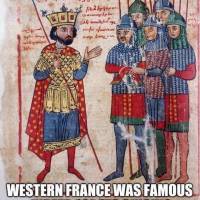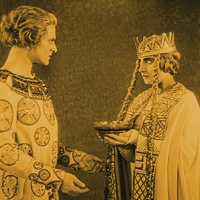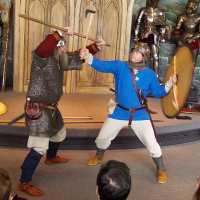
14th century illustration from Golden Haggadah of Moses being found (image source)
In Exodus, the narrator uses only three verses[1] to take the baby Moses from being handed to a Hebrew wet nurse to becoming a young adult. The story moves very quickly. After Moses is saved from the river by Pharoah’s daughter, we fast-forward to him as a young adult just in time for the scene where he kills the Egyptian. This period of baby Moses’ life is given much more attention in a 14th century version from The Middle English Metrical Paraphrase of the Old Testament than it is in Exodus.
First there’s this whole scene about how Moses refused to drink milk from any woman but his own mother and then there’s this interesting scene where Moses as a small child is brought into the royal chamber to see Pharoah. Moses’ foster-grandfather is delighted to see the bouncing boy and like every proud relative wanting to put on a show of the little guy’s brightness and good manners, he puts his crown on the young lad’s head for a Kodak moment. But little Moses, instead of sitting on Pharoah’s lap adorably modeling the big crown on his tiny head, puts the crown beneath his feet and tramples it:
“Betwyx hys schankes he sett hym right
and lappyd hym to hym for grett lufe.
And for he was so worthy a wyght,
Hys pertenes he toght forto prove.
His crown of gold, full fayr and bryght,
that barne hed sett he above.
And sone was schewyd in ther syght
a wonder case forto controve:
That child full lyghtlt lete,
the crown kast he downe,
And fylyd yt with his fete
forto breke yt full bowne.”
(ll. 1549-1560)[2]
Pharaoh’s advisors are appalled by this blatant scene of Jewish insubordination. They warn Pharaoh of the danger of allowing the Hebrew boy to grow to a man and they scoff at Pharaoh’s allowing him to live so close to the royal family. Pharoah hears nothing of their nonsense though – Moses is a clever little boy but he cannot possibly understand the implication of his action in light of current Egyptian-Jewish political tensions much less the prophecy that a Hebrew man will end Pharoah’s rule. It’s just a cute scene and besides – kids do the darndest things! Another advisor – who the text describes as “a wys man of ther law” – chimes in to defend the little child suggesting they conduct an experiment to test his cleverness. Some hot coals are brought in and presented to the little boy and sure enough Moses tries to put them in his mouth. So there you have it, he’s only a cute little boy who doesn’t yet know to be careful around burning objects.
At this moment Pharoah’s daughter (called Tremouth in The Paraphrase) rushes into the scene and takes the poor child in her arms back to her chamber to comfort him. The narrator reminds us that God always comes to those in need for he who saves shall be saved:
“Loe how sone God hath socur sent;
That He wyll save, be savyd thei sall.”
Why this scene? Was it for comedic purpose? Was it an original embellishment?
Turns out, it’s adapted from a 1st century text by Josephus called Antiquities of the Jews. Here’s the scene as it appears in Antiquities:
Thermuthis therefore perceiving him to be so remarkable a child, adopted him for her son, having no child of her own. And when one time had carried Moses to her father, she showed him to him, and said she thought to make him her successor, if it should please God she should have no legitimate child of her own; and to him, “I have brought up a child who is of a divine form, and of a generous mind; and as I have received him from the bounty of the river, in , I thought proper to adopt him my son, and the heir of thy kingdom.” And she had said this, she put the infant into her father’s hands: so he took him, and hugged him to his breast; and on his daughter’s account, in a pleasant way, put his diadem upon his head; but Moses threw it down to the ground, and, in a puerile mood, he wreathed it round, and trod upon his feet, which seemed to bring along with evil presage concerning the kingdom of Egypt. But when the sacred scribe saw this, (he was the person who foretold that his nativity would the dominion of that kingdom low,) he made a violent attempt to kill him; and crying out in a frightful manner, he said, “This, O king! this child is he of whom God foretold, that if we kill him we shall be in no danger; he himself affords an attestation to the prediction of the same thing, by his trampling upon thy government, and treading upon thy diadem. Take him, therefore, out of the way, and deliver the Egyptians from the fear they are in about him; and deprive the Hebrews of the hope they have of being encouraged by him.” But Thermuthis prevented him, and snatched the child away. And the king was not hasty to slay him, God himself, whose providence protected Moses, inclining the king to spare him.[3]
Besides adding the bit about the hot coal test, the scene was not an embellishment at all by the Paraphrase poet. In fact, it’s a surprisingly accurate translation given his version was put into Middle English verse with a slightly comedic mood. Makes me wonder what other texts the Paraphrase poet used to prepare his version of the Old Testament.
[1] Exodus 2:8-10: Douay-Rheims: http://www.drbo.org/chapter/02002.htm ; KJV: https://www.biblegateway.com/passage/?version=KJV&search=Exodus%202
[2] References to Exodus from the Metrical Paraphrase are taken from The Middle English Metrical Paraphrase of the Old Testament, ed. Michael Livingston (Kalamazoo, 2011).
[3] Flavius Josephus, Antiquities of the Jews, trans. William Whiston. Available online: http://www.biblestudytools.com/history/flavius-josephus/antiquities-jews/book-2/chapter-9.html










